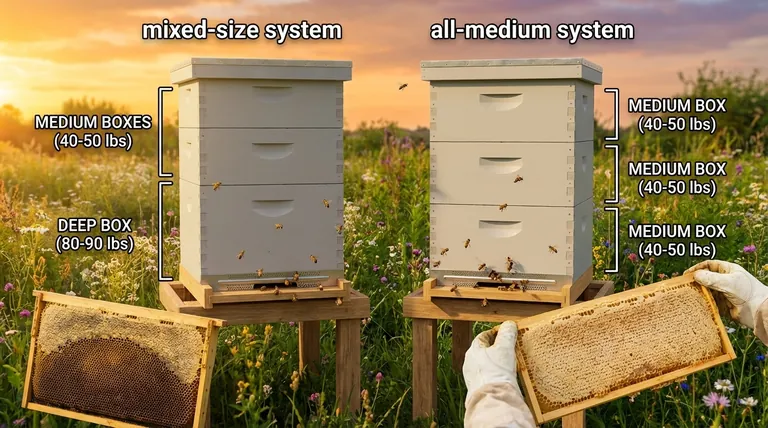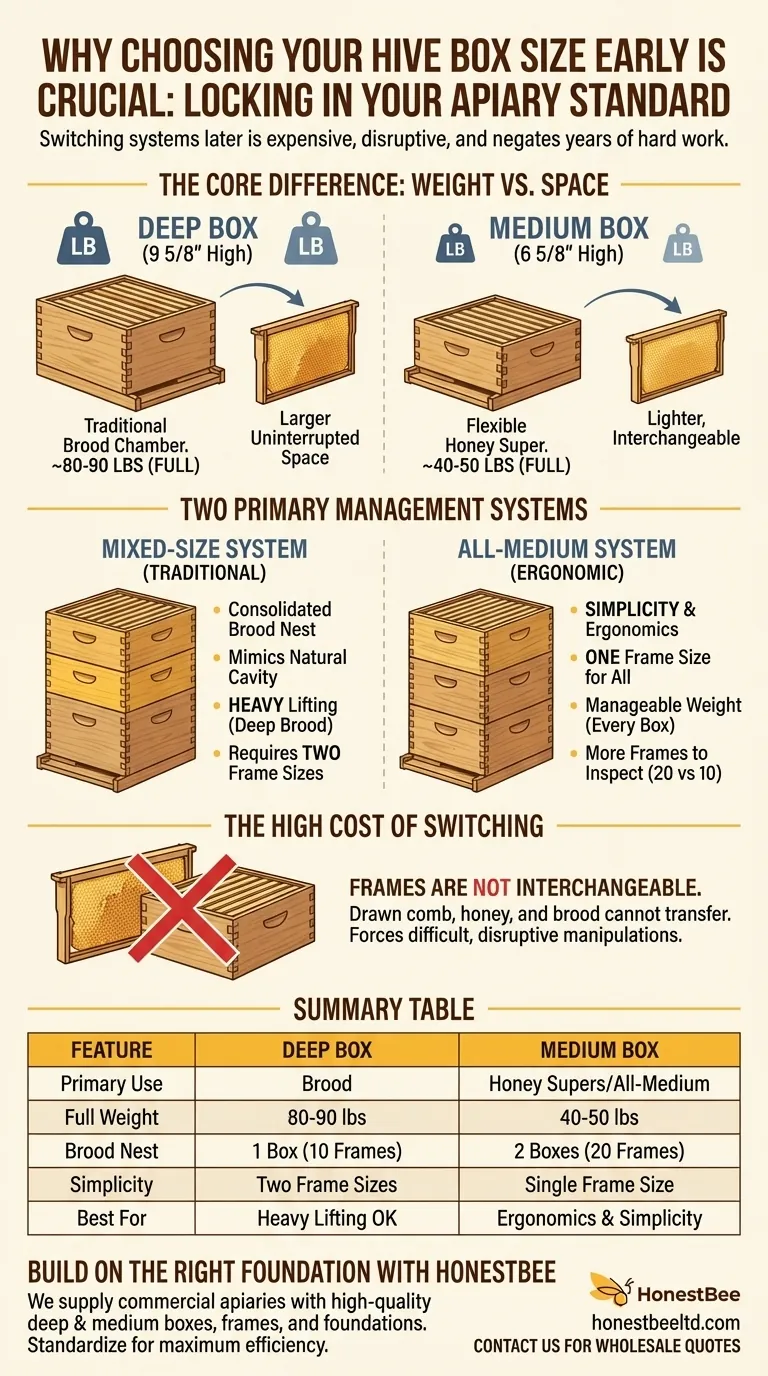Choosing your hive box size early is crucial because this decision locks you into an equipment standard for the life of your apiary. All your future boxes, frames, and foundation will need to match this initial choice. Switching systems later is not only expensive but also incredibly disruptive to your bees and negates years of hard work.
The question isn't which box is inherently "better," but which system—medium or deep—best aligns with your physical abilities and long-term management style. This single choice dictates the weight you'll lift and how you interact with your hives for years.

The Core Difference: Weight vs. Space
The primary distinction between deep and medium hive bodies comes down to a simple trade-off. Deeps offer more uninterrupted space in a single box, while mediums offer lighter weight and interchangeability.
Deep Boxes: The Brood Chamber Standard
A deep hive body (9 5/8" high) is the traditional standard for the brood chamber, the area where the queen lays her eggs and the colony raises new bees.
Their main advantage is containing the entire brood nest within a single box, simplifying inspections focused on queen health and population growth. The significant drawback is weight; a deep box full of honey, pollen, and brood can easily weigh 80-90 pounds.
Medium Boxes: The Flexible Workhorse
A medium hive body (6 5/8" high) is the standard for honey supers, the boxes placed on top of the brood chamber for honey storage.
Their key advantage is a much more manageable weight, with a full box typically weighing 40-50 pounds. This has led many beekeepers to adopt an "all-medium" system, using medium boxes for both the brood chamber and honey supers.
Understanding the Trade-offs
Your choice commits you to one of two primary management systems, each with distinct benefits and drawbacks.
The All-Medium System
In this approach, you use only medium-sized boxes for everything. The brood chamber typically consists of two medium boxes, and honey supers are additional medium boxes stacked on top.
The primary benefit is simplicity and ergonomics. You only need one size of frame and foundation, and every box you lift is a manageable weight. The main trade-off is that a complete brood nest inspection requires you to look through two boxes and 20 frames instead of one box and 10 frames.
The Mixed-Size System
This is the traditional method, using one or two deep boxes for the brood chamber and stacking medium boxes on top for honey supers.
The advantage is a consolidated brood nest that mimics a more natural cavity shape. The significant disadvantage is the weight of the deep brood boxes. It also requires you to purchase and manage two different sizes of frames and foundation.
The High Cost of Switching
It is critical to understand that frames are not interchangeable between deep and medium boxes. The comb that your bees painstakingly draw out on a deep frame will not fit inside a medium box, and vice-versa.
Changing your mind after a season or two means you cannot transfer your existing frames of drawn comb, honey, and brood to the new equipment. This forces a difficult and disruptive "shook swarm" or other advanced manipulations, setting your colony's progress back significantly.
How to Make the Right Choice
Your decision should be based on a realistic assessment of your goals and physical capabilities.
- If your primary focus is minimizing heavy lifting or you value simplicity: An all-medium system is the clear choice, as it ensures no single piece of equipment becomes too heavy to manage safely.
- If your primary focus is following traditional methods and you are comfortable with heavy lifting: A mixed system using deeps for the brood chamber and mediums for honey supers is the established standard.
Ultimately, this decision is about designing a beekeeping practice that is sustainable for your body, ensuring the hobby remains a source of enjoyment rather than a physical strain.
Summary Table:
| Feature | Deep Box (9 5/8") | Medium Box (6 5/8") |
|---|---|---|
| Primary Use | Traditional brood chamber | Honey supers or all-medium system |
| Full Box Weight | 80-90 lbs | 40-50 lbs |
| Brood Nest | Single box (10 frames) | Typically 2 boxes (20 frames) |
| System Simplicity | Requires managing two frame sizes | Single frame size for everything |
| Best For | Beekeepers comfortable with heavy lifting | Beekeepers prioritizing ergonomics & simplicity |
Ready to build your apiary on the right foundation?
Choosing the correct hive box system is the first step to a successful and sustainable beekeeping operation. At HONESTBEE, we supply commercial apiaries and beekeeping equipment distributors with the high-quality, durable deep and medium boxes, frames, and foundations needed to support your chosen system.
Let our wholesale-focused expertise help you standardize your equipment for maximum efficiency. Contact our team today to discuss your needs and request a quote.
Visual Guide

Related Products
- Langstroth Bee Hives Bee Keeping Box for Beginners Beekeeping
- Australian Langstroth Beehive Boxes for Beekeeping Wholesales
- Langstroth Honey Bee Box Hive Boxes for Different Depths
- Professional Insulated Plastic Bee Hives
- Long Langstroth Style Horizontal Top Bar Hive for Wholesale
People Also Ask
- What are the key features of the Langstroth beehive? A Guide to the Standard for Modern Beekeeping
- What basic equipment is needed to start beekeeping? Your Essential Guide to a Confident Start
- What is the best type of bee hive for beginners? Start with the Proven Langstroth Standard
- Why are Langstroth hives recommended for beginners? Unmatched Support & Standardization
- How does the orientation of the hive sides benefit comb construction? Ensure Straight, Movable Combs for Easier Hive Management



















